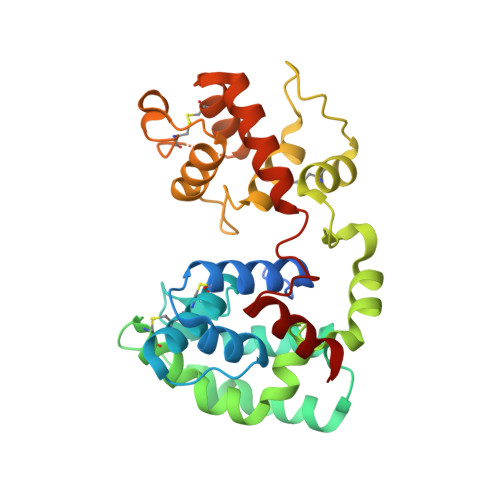A mosquito hemolymph odorant-binding protein family member specifically binds juvenile hormone.
Kim, I.H., Pham, V., Jablonka, W., Goodman, W.G., Ribeiro, J.M.C., Andersen, J.F.(2017) J Biol Chem 292: 15329-15339
- PubMed: 28751377
- DOI: https://doi.org/10.1074/jbc.M117.802009
- Primary Citation of Related Structures:
5V13 - PubMed Abstract:
Juvenile hormone (JH) is a key regulator of insect development and reproduction. In adult mosquitoes, it is essential for maturation of the ovary and normal male reproductive behavior, but how JH distribution and activity is regulated after secretion is unclear. Here, we report a new type of specific JH-binding protein, given the name mosquito juvenile hormone-binding protein (mJHBP), which circulates in the hemolymph of pupal and adult Aedes aegypti males and females. mJHBP is a member of the odorant-binding protein (OBP) family, and orthologs are present in the genomes of Aedes , Culex , and Anopheles mosquito species. Using isothermal titration calorimetry, we show that mJHBP specifically binds JH II and JH III but not eicosanoids or JH derivatives. mJHBP was crystallized in the presence of JH III and found to have a double OBP domain structure reminiscent of salivary "long" D7 proteins of mosquitoes. We observed that a single JH III molecule is contained in the N-terminal domain binding pocket that is closed in an apparent conformational change by a C-terminal domain-derived α-helix. The electron density for the ligand indicated a high occupancy of the natural 10 R enantiomer of JH III. Of note, mJHBP is structurally unrelated to hemolymph JHBP from lepidopteran insects. A low level of expression of mJHBP in Ae. aegypti larvae suggests that it is primarily active during the adult stage where it could potentially influence the effects of JH on egg development, mating behavior, feeding, or other processes.
Organizational Affiliation:
From the Laboratory of Malaria and Vector Research, NIAID, National Institutes of Health, Rockville, Maryland 20852 and.















